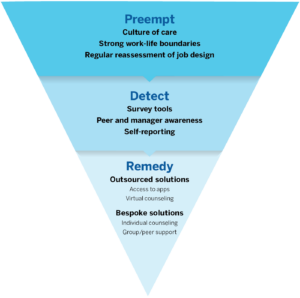Employee Mental Health
Recent research conducted by Oracle and Workplace Intelligence found that 2020 was the most stressful year people have ever experienced in their working lives. 78% of the employees surveyed said that the pandemic has negatively affected their mental health and 85% reported that newfound work-related stress is affecting their home lives.
As vaccinations become more available and some companies have begun initiating their return-to-work plans, the end of the pandemic may be in sight. However, the COVID-19 pandemic will likely have long-lasting impacts on the mental health of employees.
Addressing Employee Mental Health
Now is the perfect time to start strategizing the best way for your company to address mental health in the workplace, both now and for a post-COVID workplace. A recent article published in the MIT Sloan Management Review, suggests using the Sieve Model as a guide for addressing mental health in the workplace.
As you can see in the model above, leaders can address mental health in three main areas: preempting work stressors, detecting emerging issues, and remedying identified issues.
- At the preemptive stage, a focus on the organizational culture is essential to promote self-care values and healthy work-life boundaries. Leaders can proactively address these issues in a number of ways, including modeling wellness and work-life balance, monitoring workloads, assisting with both individual and company goal settings, and reiterating company values.
- Creating a culture of awareness, support and self-acceptance is an important step in helping to detect emerging issues. In addition, leaders need to be embedding wellness in the employee review process and actively listening to employee concerns and feedback. These steps help you receive honest answers during pulse surveys, which can detect and help prevent emerging issues.
- When it comes to remedying identified issues, the pandemic has presented many challenges. Traditional in-person wellness programs have, of necessity, gone primarily virtual. While providing access to mental health apps, such as Headspace, and virtual counseling is beneficial, leaders may want to also consider more bespoke solutions. Peer support and group exchanges can be useful within a supportive organizational culture that alleviates the stigma of revealing one’s struggle. If able, organizations should also consider having on-staff mental health professionals to support team members.
For more information on the strategic rethinking of mental health support and to learn more on how to create the right structures at the organizational level, click here!









